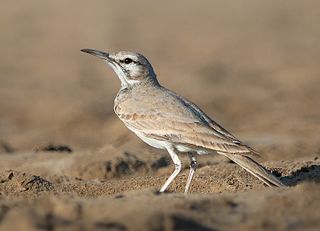
The greater hoopoe-lark is a passerine bird which is a breeding resident of arid, desert and semi-desert regions from the Cape Verde Islands across much of northern Africa, through the Arabian peninsula, Syria, Afghanistan, Pakistan and India. It was formerly known as the bifasciated lark and sometimes as the large desert lark.
Agropyron desertorum is a plant species in the family Poaceae which was originally from Russian and Siberian steppes until it was introduced to the United States from there between 1907 and 1913. Prior to its introduction it was believed that Desert wheatgrass and crested wheatgrass are different species. Currently it can still be found in Central and Western United States, except for Idaho, Kansas, Louisiana, Minnesota, Oklahoma, and Washington.

Certhilauda is a genus of larks in the family Alaudidae living in the southern regions of Africa. The genus was formerly named Heterocorys.

Artemisia spinescens is a North American species of sagebrush in the sunflower family, known by the common name budsage.

Brickellia desertorum is a species of flowering plant in the daisy family known by the common names desert brickellbush and desert brickellia. It is native to Mexico, Central America, the West Indies, and the southwestern United States.
Paragigagnathus is a genus of mites in the Phytoseiidae family.
Paragigagnathus amantis is a species of mite in the family Phytoseiidae.
Paragigagnathus bidentatus is a species of mite in the family Phytoseiidae.
Paragigagnathus cataractus is a species of mite in the family Phytoseiidae.
Paragigagnathus insuetus is a species of mite in the family Phytoseiidae.
Paragigagnathus molestus is a species of mite in the family Phytoseiidae.
Paragigagnathus namibiaensis is a species of mite in the family Phytoseiidae.
Paragigagnathus tamaricis is a species of mite in the family Phytoseiidae.

Myrmecia desertorum is an Australian ant species belonging to the genus Myrmecia. They were first described by Wheeler in 1915, and are distributed all over Australia.
Agdistis desertorum is a moth of the family Pterophoridae. It is found in Libya.

Acacia desertorum is a shrub belonging to the genus Acacia and the subgenus Juliflorae that is endemic to western Australia.
Aspergillus desertorum is a species of fungus in the genus Aspergillus which has been isolated from desert soil. It is from the Nidulantes section. Aspergillus desertorum produces desertorin A, desertorin B, desertorin C, paxiline and emindol DA.

Pogonomyrmex desertorum, the large seed harvesting ant, is a species of ant in the family Formicidae.

Chenopodium desertorum, common name frosted goosefruit, is a species of flowering plant in the family Amaranthaceae, indigenous to Australia where it is found in all mainland states.
The Central Deserts robust slider is a species of skink found in Northern Territory, South Australia, and Western Australia.







